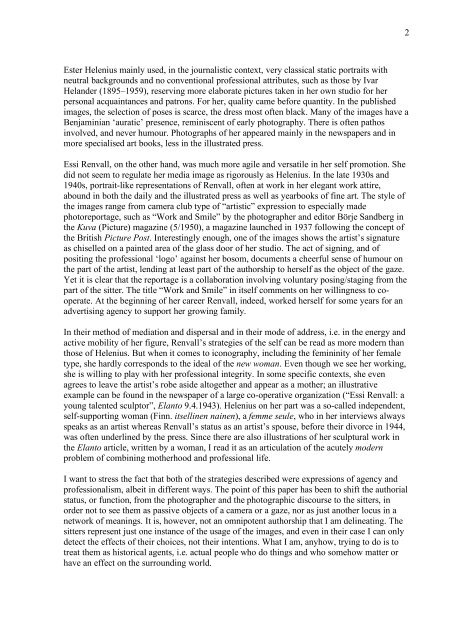Tutta Palin
Tutta Palin
Tutta Palin
Create successful ePaper yourself
Turn your PDF publications into a flip-book with our unique Google optimized e-Paper software.
2<br />
Ester Helenius mainly used, in the journalistic context, very classical static portraits with<br />
neutral backgrounds and no conventional professional attributes, such as those by Ivar<br />
Helander (1895–1959), reserving more elaborate pictures taken in her own studio for her<br />
personal acquaintances and patrons. For her, quality came before quantity. In the published<br />
images, the selection of poses is scarce, the dress most often black. Many of the images have a<br />
Benjaminian ‘auratic’ presence, reminiscent of early photography. There is often pathos<br />
involved, and never humour. Photographs of her appeared mainly in the newspapers and in<br />
more specialised art books, less in the illustrated press.<br />
Essi Renvall, on the other hand, was much more agile and versatile in her self promotion. She<br />
did not seem to regulate her media image as rigorously as Helenius. In the late 1930s and<br />
1940s, portrait-like representations of Renvall, often at work in her elegant work attire,<br />
abound in both the daily and the illustrated press as well as yearbooks of fine art. The style of<br />
the images range from camera club type of “artistic” expression to especially made<br />
photoreportage, such as “Work and Smile” by the photographer and editor Börje Sandberg in<br />
the Kuva (Picture) magazine (5/1950), a magazine launched in 1937 following the concept of<br />
the British Picture Post. Interestingly enough, one of the images shows the artist’s signature<br />
as chiselled on a painted area of the glass door of her studio. The act of signing, and of<br />
positing the professional ‘logo’ against her bosom, documents a cheerful sense of humour on<br />
the part of the artist, lending at least part of the authorship to herself as the object of the gaze.<br />
Yet it is clear that the reportage is a collaboration involving voluntary posing/staging from the<br />
part of the sitter. The title “Work and Smile” in itself comments on her willingness to cooperate.<br />
At the beginning of her career Renvall, indeed, worked herself for some years for an<br />
advertising agency to support her growing family.<br />
In their method of mediation and dispersal and in their mode of address, i.e. in the energy and<br />
active mobility of her figure, Renvall’s strategies of the self can be read as more modern than<br />
those of Helenius. But when it comes to iconography, including the femininity of her female<br />
type, she hardly corresponds to the ideal of the new woman. Even though we see her working,<br />
she is willing to play with her professional integrity. In some specific contexts, she even<br />
agrees to leave the artist’s robe aside altogether and appear as a mother; an illustrative<br />
example can be found in the newspaper of a large co-operative organization (“Essi Renvall: a<br />
young talented sculptor”, Elanto 9.4.1943). Helenius on her part was a so-called independent,<br />
self-supporting woman (Finn. itsellinen nainen), a femme seule, who in her interviews always<br />
speaks as an artist whereas Renvall’s status as an artist’s spouse, before their divorce in 1944,<br />
was often underlined by the press. Since there are also illustrations of her sculptural work in<br />
the Elanto article, written by a woman, I read it as an articulation of the acutely modern<br />
problem of combining motherhood and professional life.<br />
I want to stress the fact that both of the strategies described were expressions of agency and<br />
professionalism, albeit in different ways. The point of this paper has been to shift the authorial<br />
status, or function, from the photographer and the photographic discourse to the sitters, in<br />
order not to see them as passive objects of a camera or a gaze, nor as just another locus in a<br />
network of meanings. It is, however, not an omnipotent authorship that I am delineating. The<br />
sitters represent just one instance of the usage of the images, and even in their case I can only<br />
detect the effects of their choices, not their intentions. What I am, anyhow, trying to do is to<br />
treat them as historical agents, i.e. actual people who do things and who somehow matter or<br />
have an effect on the surrounding world.
















